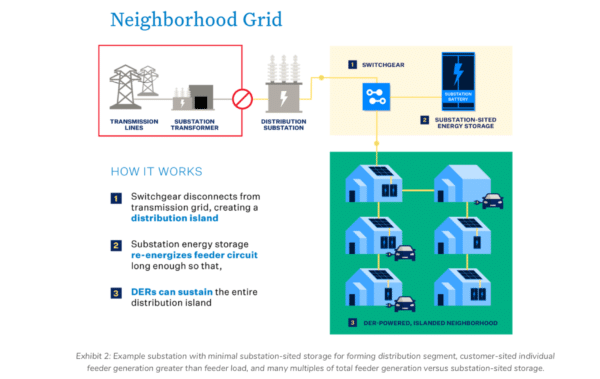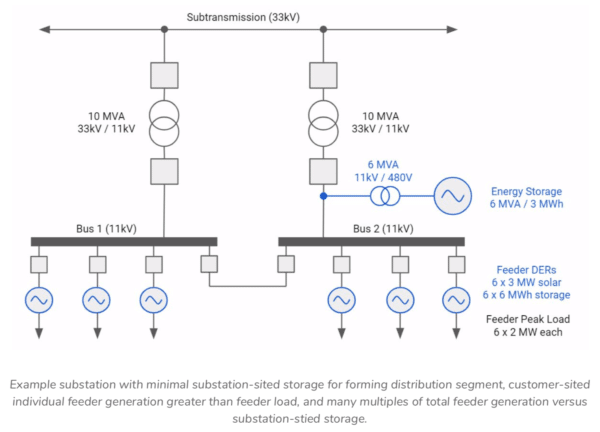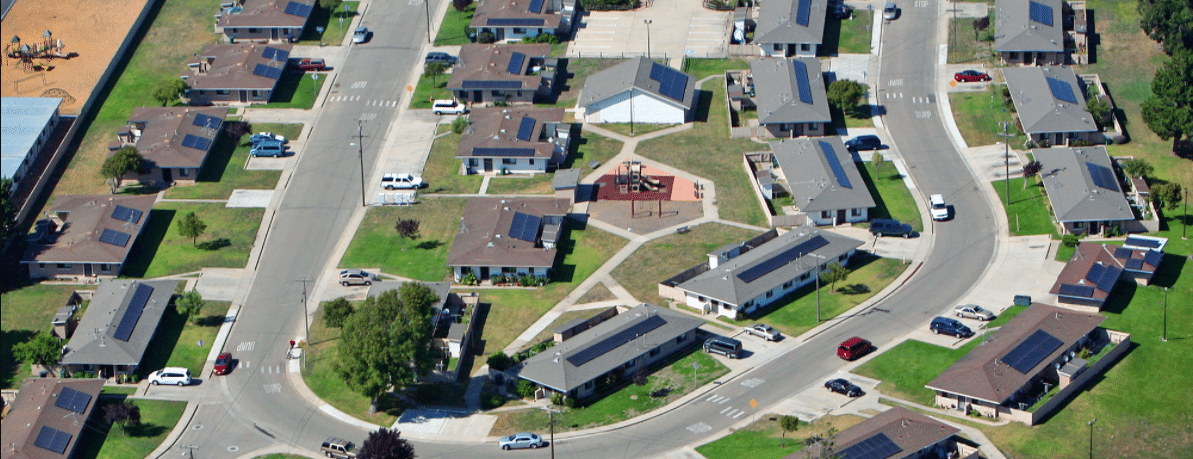In response to a Pacific Gas and Electric system reliability request for proposals calling for “renewable natural gas substation-level microgrids,” third-party solar giant Sunrun has published a concept paper outlining how distributed energy resources can reliably supply the same services as those gas-powered microgrids
After a disastrous fall and winter marred by the company’s Public Safety Power Shutoff (PSPS) events, PG&E issued the aforementioned request for proposal (RFP) in order to alleviate the strain on the company’s aging and failing transmission and distribution system.
The paper was authored by Sunrun employees in the Energy Services and Grid Solutions departments and reviewed by a senior engineer at the National Renewable Energy Laboratory, Andy Hoke, and director of electric grid research at the California Institute for Energy and Environment and a faculty scientist at Lawrence Berkeley National Laboratory, “Sascha” Alexandra Von Meier. A number of renewable energy advocates took exception to the RFP as well.
“We wanted to imagine a world where a large majority of customers do have rooftop solar,” shared VP of energy services at Sunrun and paper co-author, Dr. Audrey Lee. “In that future, how can we help not only our customers, but their neighbors as well?”
This led the authors to their preferred solution: distribution circuits, supported by consumer-sited distributed energy resources (DERs) and an initial battery bank used to start the re-energization process.

The paper presents a more futuristic outlook than PG&E’s RFP, a fact cited by the authors. In introducing the concept, the group identifies the needs for further research and technological advancements, as well as a rapid increase in the adoption of distributed energy resources.
Lee said that since the implementation of the PSPS, Sunrun has seen a battery attachment rate of 30% for new solar installations in California all new solar installations, a higher figure than normal.
“In an outage situation, our customers who do have rooftop solar and batteries can island from the grid and can maintain power and backup their critical load, but their neighbors cannot share their power directly,” continued Lee. “The idea is that we build a grid that can sectionalize much more easily when there’ s a wildfire risk and portions of the grid need to be shut down.”
The idea is to disconnect distribution substations from the transmission grid during planned outages and use energy stored in batteries at the distribution substation to re-energize individual distribution circuits on the local level. This re-energization would be triggered by a substation-sited energy storage installation, be that a traditional lithium-ion battery or other technologies like fuel cells or flywheels.
The authors outline what a system under the distribution substation solution would look like.

Though not the first to make this argument, Lee has become accustomed to the idea that the energy grid as we know it is ripe for change:
The traditional model of a centralized grid with power going from these centralized power plants to transmission and distribution systems and finally to the home may not be the right model any more.
The paper calls the distribution substation solution the preferred scenario of the three developed to alleviate the resiliency and safety issues plaguing PG&E’s grid. The other potential solutions involved either wholesale upgrades to transmission and distribution infrastructure with solar and storage providing grid services or individuals investing in personal backup without any utility support.
The proposed solution would be less expensive in implementation than transmission and distribution upgrades, while not taking nearly as long as some potential transmission and distribution upgrades, such as burying lines. In opposition to personal backup, the disconnected distribution substation solution would ideally ensure that no customers are left in the dark while eliminating the need for gas generators as a backup source.
This content is protected by copyright and may not be reused. If you want to cooperate with us and would like to reuse some of our content, please contact: editors@pv-magazine.com.









Although not directly addressed in this article, Exhibit 2 clearly includes EV storage integration. This is key. In a typical PSPS event, grid power can be out for days, not merely hours. Typical fixed residential storage batteries are designed to flatten the solar system duck curve & provide a few hours of backup power during short term outages. In a PSPS event, you need some really big, distributed batteries, like the one in a Tesla or comparable EV, to keep you powered for days. Most commuter EVs probably return home in the evening with at least 60% charge, having been plugged into a charger at work during the day. That’s a huge amount of storage, compared to typical fixed residential batteries. That’s the future.
A lot of us in the solar industry share this vision regarding the transformation of the grid. Unfortunately, it seems to be falling on deaf ears, including grass-root groups that support solar. Those groups are focused on larger solar farms that would still require a large, centralized grid. We are at a crossroads where we have an opportunity to transform the grid and microgrids are the answer, for a lot more reasons than stated in this article.
“The idea is to disconnect distribution substations from the transmission grid during planned outages and use energy stored in batteries at the distribution substation to re-energize individual distribution circuits on the local level. This re-energization would be triggered by a substation-sited energy storage installation, be that a traditional lithium-ion battery or other technologies like fuel cells or flywheels.”
I’m thinking, PG&E has already proven that their “underground” natural gas line assets are in no better shape than their above ground electrical assets. San Bruno and that gas main explosion in 2010 is a testament to how lousy PG&E has been in its own O&M endeavors. Yeah, the PG&E ‘fix’ for wildfires is PSPS economic Carenage, the ‘fix’ for grid isolation is use underground assets to ‘fuel’ micro turbines that may blow out and take an entire housing tract with it. It sucks to be PG&E right now.
A new startup is doing just as the article states in an Opportunity zone
for agriculture housing utilizing storage as well. Their concept builds further with Structural Insulated Panels for the envelop. Their claim is it costs a lot less to build with a solar roof system. It’s hard to believe that in Southern California this could be available.
I think many share the vision (and hope) for transformation of the existing grid, adding rooftop PV systems and small to medium storage capacities individually at home, with an eye on communities developing neighborhood and small grid substations that provide backup for the inevitable PSPS events. I say this because PG&E is too big and stodgy to transform the existing structure to the needs of the changing world. Ideas and proposals seem to be coming together, as in this article, and talk for meaningful and impactful changes appear to be taking hold. What is the best way to turn papers to plans, turn talk into action? How can individuals become activists? Is there an organized grassroots effort out there?
There’s been a ‘concept’ from the 1970’s when solar PV early adopters were using early 50 watt/ $500 solar PV panels for very small loads. Now even with tariffs in place one can get solar PV panels in pallet quantities for around $0.80/watt, that’s an average of $265 for a 330 watt solar PV panel. so, yeah from $100/watt to $0.80/watt, from now on the price will not drop so precipitously. It could be possible in the next 5 years, tandem solar PV panels in the 30% to 35% efficiency could be selling for that $0.80 or even a little less per watt, with panels that can put out 510 to 595 watts of power from the same square feet of panel area. Once again more power for less. The grass roots effort has been around for about 50 years now. The technology is available now, for a comprehensive home alternative energy system, with or without an EV parallel connection. Talk into action? Right now we are marveling at the Corona virus and its (effect) on the Stock Market and economies in many countries. So, where does one put their ‘money’ where it will do the most good? The bank will gladly “give” you a lousy 0.5% to 1.5% APY on savings in the bank. Take that money out of the bank and install your own solar PV and energy storage system in your home. Getting rid of an average electric bill of $100? $200, $300 a month will give one a better return on investment than leaving the money in the bank. Among other things, there is a group on the internet calling themselves (grassrootssolar), there is (wholesalesolar) and (bluepacificsolar).